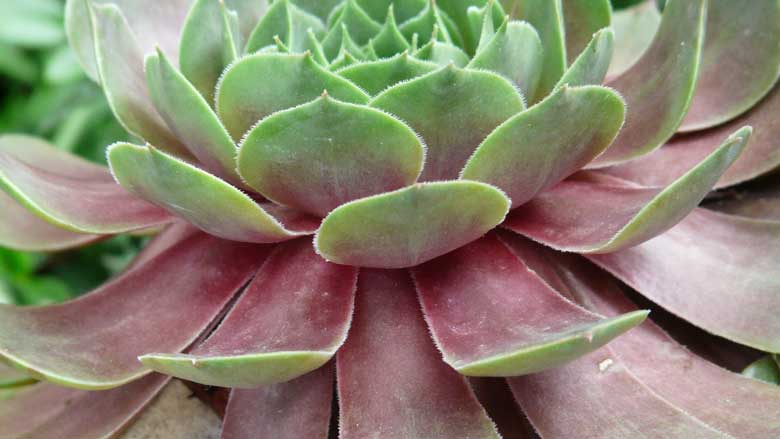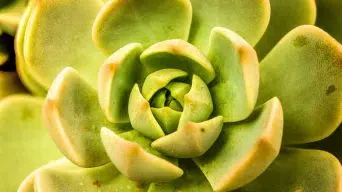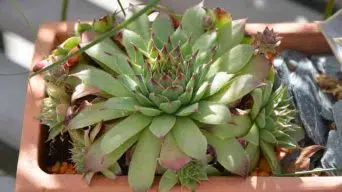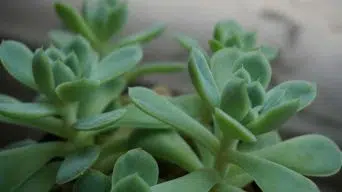Succulents turn red due to stress factors like drought, excessive sun, poor soil, cold temperatures, high salt levels, being root-bound, heat stress, or over-fertilization. Addressing these issues by adjusting watering, sunlight exposure, pot size, soil quality, and temperature is key to maintaining their health.
Succulents are among the easiest plants to grow indoors, requiring minimal care and demonstrating remarkable resilience.
However, a common query arises when succulents unexpectedly turn red.
This article delves into the common causes behind the reddening of succulents and offers guidance on preserving their vibrant green hue.
What Causes Succulent Plants to Change Color?
A lot is going on inside succulent plants, which helps them gain such unique colors when exposed to certain conditions.
Succulents have adapted to what we see today because it allows them to survive through difficult living conditions like drought or desert climates where finding water is rare.
Leaf succulents tend to change colors when experiencing stress or environmental changes.
When under environmental stress, succulent leaves can change color because the heightened coloration signals animals to stay away.
It works in much the same way that brightly colored berries warn other succulent eaters of its bitter taste and toxicity levels.
This allows succulents to survive longer through dry seasons and long periods without succulent eaters.
Different species of succulents can look drastically different under stress, which is why we see such a variety in coloration between them.
When the succulent has adapted to its environment over time, it produces more chlorophyll to convert energy from sunlight into food to survive.
Extended exposure to intense sunlight can lead to succulents developing red, orange, or yellow hues.
Occasionally, succulents will change colors because of the conditions provided for them.
For example, placing your succulent in direct sunlight may cause leaves to become red or pinkish instead of green, depending on how long it has been exposed to the sun.
If there isn’t enough water available, then succulents can turn purple or brown as a way for them to hold onto what little amount of water they have left inside their cells until rainfall occurs again.
Do All Succulents Change Colors?
Succulents exhibit diverse reactions to their environments, particularly in color changes under varying conditions.
For instance, Aloe succulents, well-adapted to intense sun, may develop a mild red hue but are generally less affected than other varieties. These plants can lose leaves due to insufficient nutrients, which doesn’t necessarily lead to color changes in other succulents under similar conditions.
Conversely, cacti succulents respond to high sunlight exposure by bleaching their skin rather than altering color. This bleaching is a defense mechanism, creating a withered appearance that deters predators.
Succulents rich in moisture, found in their leaves, stems, or roots, usually retain their color under normal circumstances. However, if these plants suffer severe damage, they can exhibit vivid colors.
Certain succulents may get red or pink in colder climates, especially when their leaves are significantly damaged. This response is a protective measure to safeguard the stem in harsh, cold conditions.
Why Should I Care If My Succulent Is Turning Red
A succulent displaying red hues is an indicator of distress.
This color change might result from improper care or a new environment where the plant lacks sufficient water.
Ignoring this transformation can harm the plant’s health, potentially leading to its demise.
Addressing the issue promptly is crucial for the survival of your succulent.
Factors Contributing to Red Coloration in Succulents
Succulents often turn red for various reasons, signaling a need for attention to their survival conditions. This color change can be triggered by inadequate water, excessive direct sunlight, or overall growing conditions.
For instance, a leafy succulent might develop pinkish-red leaves, while others may display brown and purple hues due to insufficient moisture in the soil.
Understanding these signals is crucial, as it allows you to take necessary steps to improve their living conditions and prevent their decline.
Red leaves on a succulent are a clear indication of distress. The most common reasons for this color shift include:
Drought Stress
Succulents exhibit redness in their leaves and stems when experiencing drought stress. This condition hinders their cells from retaining water effectively.
Insufficient moisture causes succulents to wilt, weaken, and, if neglected, eventually perish.
The reddening of succulents serves as an urgent signal for watering. Addressing this need promptly is crucial to prevent their demise.
Direct Sunlight
Succulents are very sensitive when it comes to direct sunlight.
If succulents are exposed to too much sun, the leaves turn red because they can’t handle the amount of UV rays produced by the sun, which causes succulent cells to break down and lose their elasticity.
Poor Soil Quality
Succulents often get red when planted in nutrient-deficient soil, lacking the essential elements for survival.
Additionally, overly acidic soil can cause succulents to redden. In such environments, the leaves may become weak and limp.
Prolonged exposure to dry conditions in these poor soils can lead to leaf death.
Cold Temperatures
Succulents often change color to red due to cold temperatures.
This change occurs when their leaves and stems, especially the red tips, are exposed to environments below 50 degrees Fahrenheit.
In such conditions, the cells of the succulents are pushed to their limits, triggering the reddening process.
High Salt Levels
Succulents will get reddish when succulent leaves are exposed to high levels of salt that prevent them from absorbing the water they need.
It is essential not to use fertilizers or salts on succulents as it can cause succulent plants to become extremely thirsty and eventually die off if you don’t take care of the problem.
Root Bound
When succulents are root-bound, their roots are constricted, often leading them to turn red.
Overcrowding in a pot restricts their access to adequate water and nutrients, underscoring the importance of sufficient space for growth.
If succulents keep dying off or turning colors, it may be time to repot succulents in a bigger pot with better succulent soil.
Heat Stress
When succulents are exposed to high temperatures, they may turn red. This reaction is a sign of heat stress, which can cause their leaves and stems to lose elasticity and break down.
Prolonged exposure to heat can be deadly for these plants, as it impairs their water retention capabilities.
Over-Fertilization
Excessive fertilization also causes succulents to redden.
A fertilizer overload leads to cell breakdown, making the plants thirsty and impairing their water retention.
These plants require minimal fertilizer, ideally applied only during their growing seasons.
What Should I Do if My Succulent Leaves Turn Red?
When succulents display red leaves, it’s essential to adjust their environment to prevent further leaf loss.
Here are steps to improve their conditions.
Let the Soil Dry Out Between Waterings
Succulents will die if left in wet soil for too long, so it is essential to let the soil dry out between watering succulent plants.
Succulents must be watered deeply but infrequently, so you should water succulents only when the soil is dry.
Remove Succulent Flowers and Buds
Flowers and buds can cause the plants to turn red when left on succulents for an extended period. This occurs because these growths drain the energy essential for the succulents’ survival.
Removing any flowers or buds is important to ensure your succulents remain healthy and well-hydrated, especially during hot seasons. This allows the plants to focus solely on self-care and hydration.
Move Your Succulent Plants Inside at Night for a Few Weeks During Cold Seasons
During colder seasons, bringing your succulents indoors at night for a few weeks is advisable.
Exposure to temperatures below 50 degrees Fahrenheit can stress these plants, causing their green leaves to turn red and potentially leading to death.
By keeping them inside, succulents can conserve energy and retain more water, reducing the likelihood of stress-induced color change.
Repot Succulent Plants in a Bigger Pot with Better Soil
Succulents are prone to root binding, a condition that can be fatal. This often occurs when they are overcrowded in a pot, leading to insufficient water and nutrient absorption from the soil.
To encourage healthy growth and prevent the death of your succulents, consider repotting them in a larger pot with higher-quality soil. This will provide the necessary space for their roots to expand and thrive.
Keep Succulents Warm During Cold Seasons and Cool During Hot Seasons
Succulents can get red if their leaves and stems are exposed to high temperatures, which can cause succulent cells to break down while losing their elasticity.
If succulents stay hot for too long, succulent plants will die off because it prevents succulents from holding onto water inside succulent cells.
Stop Over-Fertilizing succulents
Excessive fertilizer exposure can lead to succulent plants turning red, a sign of distress.
Over-fertilization breaks down their cellular structure, rendering them unable to retain water effectively.
Succulents require minimal fertilizer for healthy growth. It’s important to fertilize them only during their active seasons.
Keep Succulents in Bright Indirect Sunlight
Succulents, like many houseplants, thrive in bright, indirect sunlight.
Exposing their leaves and stems to intense, direct sunlight can cause them to develop a red hue, as the cells in these plants struggle with high temperatures.
Overexposure to the sun affects their color and reduces their elasticity, increasing the risk of death.
To maintain their health, ensure that succulents receive a few hours of indirect sun daily.
Additionally, it’s crucial to protect them from harsh sun during hot days to preserve their vitality.
Final Thoughts
Cultivating succulents can be rewarding, yet their tendency to turn red often signals a problem. This color change can indicate serious underlying issues or, more commonly, excessive sun exposure.
If the latter is the case, moving your succulent to a shadier spot or indoors temporarily can help its leaves recover.
However, redness isn’t the only sign of distress in succulents.
Look for other symptoms like shriveled leaves or stems, drooping branches, color loss, wilting, or a general lack of vitality. These signs suggest your succulent is struggling in its environment.
Promptly addressing these issues is crucial to prevent further damage and restore your succulent’s health and vibrancy.







